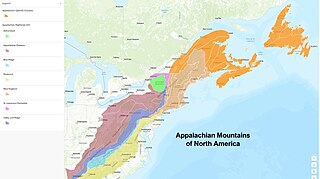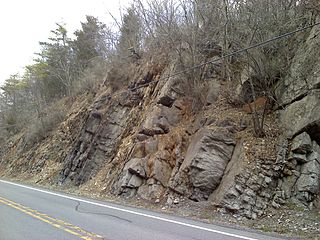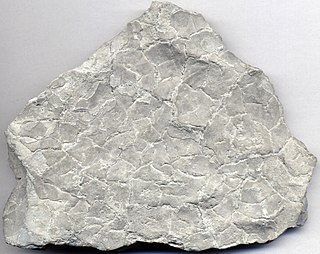
The geology of the Appalachians dates back more than 1.2 billion years to the Mesoproterozoic era when two continental cratons collided to form the supercontinent Rodinia, 500 million years prior to the development of the range during the formation of Pangea. The rocks exposed in today's Appalachian Mountains reveal elongate belts of folded and thrust faulted marine sedimentary rocks, volcanic rocks and slivers of ancient ocean floor—strong evidences that these rocks were deformed during plate collision. The birth of the Appalachian ranges marks the first of several mountain building plate collisions that culminated in the construction of Pangea with the Appalachians and neighboring Anti-Atlas mountains near the center. These mountain ranges likely once reached elevations similar to those of the Alps and the Rocky Mountains before they were eroded.

The Permian Basin is a large sedimentary basin in the southwestern part of the United States. It is the highest producing oil field in the United States, producing an average of 4.2 million barrels of crude oil per day in 2019. This sedimentary basin is located in western Texas and southeastern New Mexico. It reaches from just south of Lubbock, past Midland and Odessa, south nearly to the Rio Grande River in southern West Central Texas, and extending westward into the southeastern part of New Mexico. It is so named because it has one of the world's thickest deposits of rocks from the Permian geologic period. The greater Permian Basin comprises several component basins; of these, the Midland Basin is the largest, Delaware Basin is the second largest, and Marfa Basin is the smallest. The Permian Basin covers more than 86,000 square miles (220,000 km2), and extends across an area approximately 250 miles (400 km) wide and 300 miles (480 km) long.

Bald Eagle Mountain – once known locally as Muncy Mountain – is a stratigraphic ridge in the Ridge-and-Valley Appalachians of central Pennsylvania, United States, running east of the Allegheny Front and northwest of Mount Nittany. It lies along the southeast side of Bald Eagle Creek and south of the West Branch Susquehanna River, and is the westernmost ridge in its section of the Ridge-and-Valley Appalachians. The ridge line separates the West Branch Susquehanna Valley from the Nippenose and White Deer Hole valleys, and Bald Eagle Valley from Nittany Valley.

The Geology of Pennsylvania consists of six distinct physiographic provinces, three of which are subdivided into different sections. Each province has its own economic advantages and geologic hazards and plays an important role in shaping everyday life in the state. From the southeast corner to the northwest corner of the state, the include: the Atlantic Plain Province province, the Piedmont Province, the New England Province, the Ridge and Valley Province, the Appalachain Province, and the Central Lowlands Province.

The Ordovician Martinsburg Formation (Om) is a mapped bedrock unit in Pennsylvania, New Jersey, Maryland, Virginia, and West Virginia. It is named for the town of Martinsburg, West Virginia for which it was first described. It is the dominant rock formation of the Great Appalachian Valley in New Jersey and Pennsylvania.

The Ordovician Reedsville Formation is a mapped surficial bedrock unit in Pennsylvania, Maryland, Virginia, West Virginia, and Tennessee, that extends into the subsurface of Ohio. This rock is a slope-former adjacent to the prominent ridge-forming Bald Eagle sandstone unit in the Appalachian Mountains. It is often abbreviated Or on geologic maps.

The Clinton Group is a mapped unit of sedimentary rock found throughout eastern North America. The interval was first defined by the geologist Lardner Vanuxem, who derived the name from the village of Clinton in Oneida County, New York where several well exposed outcrops of these strata can be found. The Clinton Group and its lateral equivalents extend throughout much of the Appalachian Foreland Basin, a major structural and depositional province extending from New York to Alabama. The term has been employed in Kentucky, Maryland, Michigan, New York, Ohio, Pennsylvania, Tennessee, Virginia, and West Virginia, though in many of these areas the same interval is referred to as the Rose Hill, Rockwood, or Red Mountain Formations. Historically the term "Clinton" has also been assigned to several lower Silurian stratigraphic units in Ohio and Kentucky which are now known to be significantly older than the Clinton Group as it was originally defined. Many parts of this succession are richly fossiliferous, making the Clinton Group an important record of marine life during the early Silurian. Several economically valuable rock-types are found within this interval, though it is perhaps best known as a significant source of iron ore

Wills Creek Formation is a mapped Silurian bedrock unit in Pennsylvania, Maryland, Virginia, and West Virginia.

The Pennsylvanian Pottsville Formation is a mapped bedrock unit in Pennsylvania, western Maryland, West Virginia, Ohio, and Alabama. It is a major ridge-former in the Ridge-and-Valley Appalachians of the eastern United States. The Pottsville Formation is conspicuous at many sites along the Allegheny Front, the eastern escarpment of the Allegheny or Appalachian Plateau.

The Marcellus Formation or the Marcellus Shale is a Middle Devonian age unit of sedimentary rock found in eastern North America. Named for a distinctive outcrop near the village of Marcellus, New York, in the United States, it extends throughout much of the Appalachian Basin.
The Ordovician Kittatinny Formation or Kittatinny Limestone is a dolomitic limestone formation in New Jersey. The Kittatinny Limestones are located primarily in the Kittatinny Valley where it lies above the Ordovician Martinsburg Formation within the long valley running from Picatinny Arsenal in Rockaway Township, southwest toward Chester Township. It overlies the Cambrian Hardyston Quartzite.

The Late Silurian to Early Devonian Keyser Formation is a mapped limestone bedrock unit in Pennsylvania, Maryland, Virginia, and West Virginia.
The Shadow Lake formation is a geological unit that crops out in Southern Ontario, Canada and northern Pennsylvania, United States. The shaly sections act as a caprock to petroleum reservoirs.

The Black River Group is a geologic group that covers three sedimentary basins in the Eastern and Midwestern United States. These include the Appalachian Basin, Illinois Basin and the Michigan Basin. It dates back to the Late Ordovician period. It is roughly equivalent to the Platteville Group in Illinois. In Kentucky and Tennessee it is also known as the High Bridge Group. In areas where this Geologic Unit thins it is also called the Black River Formation (undifferentiated). One example of this is over the Cincinnati Arch & Findley Arch. Large parts of the Black River have been dolomized (where the parent limestone CaCO3 has been turned into dolomite CaMg(CO3)2.) This happed when there was interaction of hot saline brine and the limestone. This created hydrothermal dolomites that in some areas serve as petroleum reservoirs.
The Odenville Limestone is a geologic formation in Alabama. It preserves fossils dating from the early Ordovician Period.
The Mansfield Natural Gas Field is located west of Mansfield, Ohio, within the Appalachian foreland basin. The field is 1.5 miles (2.4 km) long by 1.4 miles (2.3 km) wide and is in a general oval shape, stretching northward. This field, although small, is an analog for many of the natural gas fields that occur within the Appalachian Basin. It was first discovered by the Pan American Petroleum and Transport Company in the early 1930s. It is part of the Utica – Lower Paleozoic system, which is estimated to make up 15 to 20 percent of the total hydrocarbon abundance of the Appalachian Basin.

The Durness Group is a geological group, a carbonate-dominated stratigraphic unit that forms a c. 170 km long narrow and discontinuous outcrop belt along the north-western coast of Scotland from the Isle of Skye and Loch Kishorn in the south to Durness and Loch Eriboll in the north. It forms the youngest part of the foreland basin of the Moine Thrust Belt in the Scottish Northwest Highlands and is incorporated into this belt's lowermost thrust sheets, where it is often affected by thrust faulting. It overlies the Ardvreck Group.

The Knox Supergroup, also known as the Knox Group and the Knox Formation, is a widespread geologic group in the Southeastern United States. The age is from the Late Cambrian to the Early Ordovician. Predominantly, it is composed of carbonates, chiefly dolomite, with some limestone. There are also cherty inclusions as well as thin beds of sandstone.
The Hunton Megagroup also Hunton Super Group, Hunton Group, Hunton Formation and Hunton Limestone is predominantly composed of carbonate rock, deposited between the Silurian and early to mid Devonian periods. In many States it acts as a reservoir for both hydrocarbons and water.













